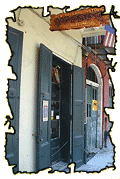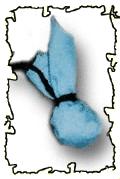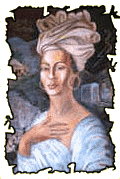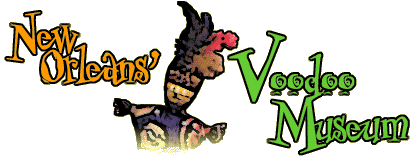 |
 |
 |
|
|||
|
New Orleans' Voodoo Museum Louis Prima, the New Orleans crooner, sang about it in a duet with his partner Keely Smith.
Louis: "Oh, that Black Magic has me in its spell. Oh, Black magic that you weave so well. Those icy fingers up and down my spine. That same old witchcraft when your eyes meet mine..." 
Witchcraft, magic potions, zombies and dolls to make your enemies cringe with pain... I can't help being taken in by these stereotypical images of voodoo. So, for a glimpse into this mysterious religion, I stop off at dusk to a small house at 724 Dumaine Street in New Orleans' French Quarter.
Charles: "Ok, just in time. We're just closing up. But you're the last, the last person. Pay at the desk if you like..." Inside the New Orleans Historical Voodoo Museum, I almost choke on the pungent incense. Over the front door hangs the jagged jawbone of an alligator, which I soon learn is called a Ju-Ju. It's a dead animal that wards off evil spirits. Charles Gandolfo, an artist with a passion for voodoo, founded the museum in 1972. In the back room, he mixes concoctions to bring success in business, school, love, or just about anything. They're called Gris Gris bags. 
Charles: "Basically, what it means is black and white powers coming together, which turns grey, which is Gris in French. And that activates the powers. And once the powers are activated, you take for whatever purpose you're doing the bag. You put various herbs, stones, bones in the bag, representing that particular purpose..." You can buy Gris Gris bags in the museum's gift shop for about ten bucks. A good insurance policy against all kinds of misfortune. Gris Gris is a unique New Orleans addition to voodoo, whose roots are in the African Yoruba religion. The city was once a major port for the slave trade, and slaves brought voodoo with them from Western Africa through Haiti and the Caribbean.
Alex: "Now, what it is basically is a form of spirit worship..." Tour guide Alex Gilchrist.
Alex: "There are spirits all around us all the time that control everything in the universe. And what people do during a ritual, more or less, is just call down one those spirits to effect whatever it controls. That's a person's way of adding input into the universe and giving them some form of control over things. Now, you guys can squeeze in. There's plenty of room here." Gilchrist ushers me into rooms crammed with sculptures, statues and altars. One wall is dominated by a portrait of Marie Laveau, the legendary queen of New Orleans voodoo. And there are bottles of rum, dollar bills and strings of Mardi Gras beads offered to Ishu, a young, mischievous spirit. He's been called the "Dennis the Menace" of the spirit world. I'm told not to get on his bad side. Nearby is a glass case filled with colorful voodoo dolls made of straw. These, Gilchrist tells me, are among the most misunderstood aspects of the religion. 
Alex: "The whole evil negative side of voodoo developed here too, again because of slavery, and I think the dolls are a good example of that. Because if a master was mean to their slave, there's nothing they could do about that. If a slave talked back, they'd be tortured. So what they would do is make a figure of a master in a doll like that, and take out all their aggressions and anxieties out on the doll, without having to physically confront the master, which is very dangerous. But it is considered evil because they were directing negative energies towards somebody else." The Neville Brothers, the city's premier group, sing about casting spells. But during the 19th century, such practices were outlawed in Louisiana, for fear that voodoo would incite slave revolts.
Alex: "Now, around here, the French Catholic plantation owners would always try to convert their slaves in order to control them better. It was a law here for many years that all slaves had to be baptized catholic. So to protect themselves, and their religion, what they did was to take voodoo underground. They hid it under Catholicism. They took the various Catholic saints and Catholic icons and put them over the place of the original African spirits. That worked as a smokescreen. That's how voodoo survived." And today, sports fans buy Gris Gris bags with hopes of bringing salvation to the city's other saints, its hapless football team. So far, it hasn't helped. And there are Gris Gris bags specifically for gamblers looking to hit it big in the Big Easy's casinos. So, if you need some good luck, or want to put a spell on your boss, or if you're merely intrigued with the city's voodoo lore, the New Orleans Historical Voodoo Museum awaits you in the French Quarter. Just remember to duck beneath the dead alligator hanging over the front door. In New Orleans, I'm Lex Gillespie for The Savvy Traveler.
|
 | American Public Media Home | Search | How to Listen ©2004 American Public Media | Terms of Use | Privacy Policy |
